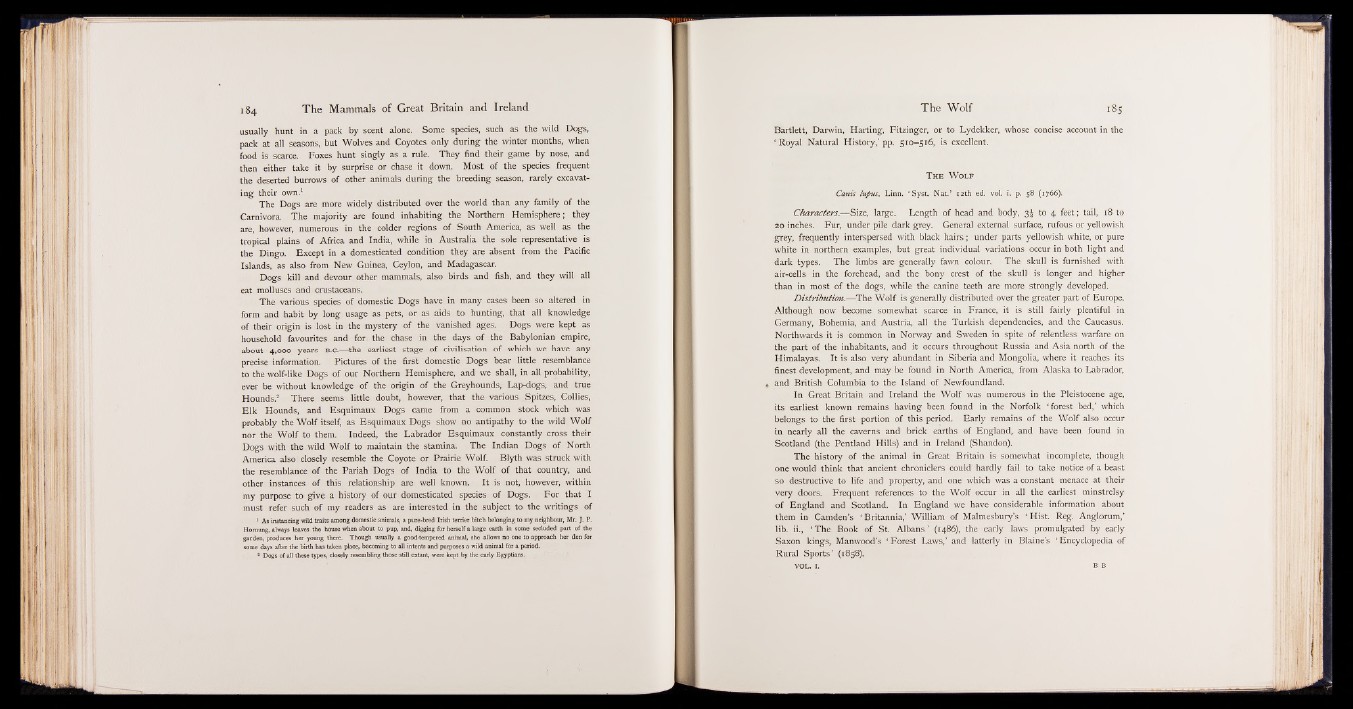
usually hunt in a pack by scent alone. Some species, such as the wild Dogs,
pack at all seasons, but Wolves and Coyotes only during the winter months, when
food is scarce. Foxes hunt singly as a rule. They find their game by nose, and
then either take it by surprise or chase it down. Most of the species frequent
the deserted burrows of other animals during the breeding season, rarely excavating
their own.1
The Dogs are more widely distributed over the world than any family of the
Carnivora. The majority are found inhabiting the Northern Hemisphere; they
are, however, numerous in the colder regions of South America, as well as the
tropical plains of Africa and India, while in Australia the sole representative is
the Dingo. Except in a domesticated condition they are absent from the Pacific
Islands, as also from New Guinea, Ceylon, and Madagascar.
Dogs kill and devour other mammals, also birds and fish, and they will all
eat molluscs and crustaceans.
The various species of domestic Dogs have in many cases been so altered in
form and habit by long usage as pets, or as aids to hunting, that all knowledge
of their origin is lost in the mystery of the vanished ages. Dogs were kept as
household favourites and for the chase in the days of the Babylonian empire,
about 4,000 years b .c .— the earliest stage of civilisation of which we have any
precise information. Pictures of the first domestic Dogs bear little resemblance
to the wolf-like Dogs of our Northern Hemisphere, and we shall, in all probability,
ever be without knowledge of the origin of the Greyhounds, Lap-dogs, and true
Hounds.2 There seems little doubt, however, that the various Spitzes, Collies,
Elk Hounds, and Esquimaux Dogs came from a common stock which was
probably the Wolf itself, as Esquimaux Dogs show no antipathy to the wild Wolf
nor the Wolf to them. Indeed, the Labrador Esquimaux constantly cross their
Dogs with the wild Wolf to maintain the stamina. The Indian Dogs of North
America also closely resemble the Coyote or Prairie Wolf. Blyth was struck with
the resemblance of the Pariah Dogs of India to the Wolf of that country, and
other instances of this relationship are well known. It is not, however, within
my purpose to give a history of our domesticated species of Dogs. For that I
must refer such of my readers as are interested in the subject to the writings of
1 As instancing wild traits among domestic animals, a pure-bred Irish terrier bitch belonging to my neighbour, Mr. J. P.
Homung, always leaves the house when about to pup, and, digging for herself a large earth in some secluded part of the
garden, produces her young there. Though usually a good-tempered animal, she allows no one to approach her den for
some days after the birth has taken place, becoming to all intents and purposes a wild animal for a period.
* Dogs of all these types, closely resembling those still extant, were kept by the early Egyptians.
Bartlett, Darwin, Harting, Fitzinger, or to Lydekker, whose concise account in the
‘ Royal Natural History,’ pp. 510-516, is excellent.
T h e W o l f
Cants lupus, Linn. 'S ys t. Nat.’ 12th ed. vol. i, p. 58 (1766).
Characters.— Size, large. Length of head and body, 3^ to 4 feet; tail, 18 to
20 inches. Fur, under pile dark grey. General external surface, rufous or yellowish
grey, frequently interspersed with black hairs; under parts yellowish white, or pure
white in northern examples, but great individual variations occur in both light and
dark types. The limbs are generally fawn colour. The skull is furnished with
air-cells in the forehead, and the bony crest of the skull is longer and higher
than in most of the dogs, while the canine teeth are more strongly developed.
Distribution.— The Wolf is generally distributed over the greater part of Europe.
Although now become somewhat scarce in France, it is still fairly plentiful in
Germany, Bohemia, and Austria, all the Turkish dependencies, and the Caucasus. .
Northwards it is common in Norway and Sweden in spite of relentless warfare on
the part of the inhabitants, and it occurs throughout Russia and Asia north of the
Himalayas. It is also very abundant in Siberia and Mongolia, where it reaches its
finest development, and may be found in North America, from Alaska to Labrador,
and British Columbia to the Island of Newfoundland.
In Great Britain and Ireland the Wolf was numerous in the Pleistocene age,
its earliest known remains having been found in the Norfolk ‘ forest bed,’ which
belongs to the first portion of this period. Early remains of the Wolf also occur
in nearly all the caverns and brick earths of England, and have been found in
Scotland (the Pentland Hills) and in Ireland (Shandon).
The history of the animal in Great Britain is somewhat incomplete, though
one would think that ancient chroniclers could' hardly fail to take notice of a beast
so destructive to life and property, and one which was a constant menace at their
very doors. Frequent references to the Wolf occur in all the earliest minstrelsy
of England and Scotland. In England we have considerable information about
them in Camden’s ‘ Britannia,’ William of Malmesbury’s ‘ Hist. Reg. Anglorum,’
lib. ii., ‘ The Book of St. Albans ’ (i486), the early laws promulgated by early
Saxon kings, Manwood’s ‘ Forest Laws,’ and latterly in Blaine’s ‘ Encyclopedia of
Rural Sports ’ (1858).
v o l . 1. B B